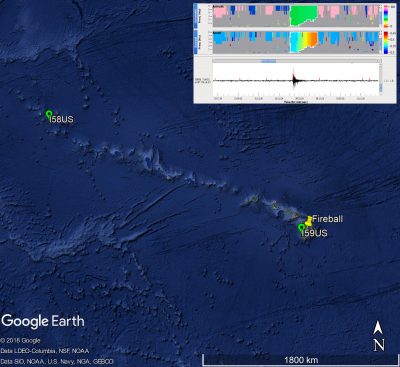There were three bright fireballs on 24. and 25 July 2019! The first one was on Wednesday early in the morning over Ontario, Canada, the second one in the evening over the US East Coast, and the third fireball occured just after midnight on Thursday over Hawaii.
The Canadian fireball occured on 24 July 2019 at 6:44 UTC (2:44 EDT). There are already more than 40 eyewitnes reports from Ontario, Québec, Michigan, New York, and Pennsylvania.
The fireball had a brightness similar to the full moon and was detected by 10 all-sky cameras of the Western’s Southern Ontario Meteor Network (SOMN) following a press release of the Western University.
It is likely that parts of the entering meteoroid reached the ground in the Bancroft area as explained by Peter Brown, Professor at Western University:
Based on the camera data the size of the entering meteoroid was estimated to be about 30 cm.
A preliminary analysis of the infrasound data of the International Monitoring System of the CTBTO did show a signal of the fireball in the data of the closest station, which had an estimated distance to the fireball of almost 1500 km. We were able to calculate a preliminary source energy of 0.7 t TNT. With the velocity of 20.2 km/s, which was published by NASA and an assumed density of 3000 kg/m³ the size of the entering meteoroid would be about 20 cm diameter.
The second fireball was visible from all over the US East Coast on Wednesday evening at 23:07 EDT (24 July 2019, or on 25 July 2019 at 3:07 UTC).
There are already more than 360 eyewitness reports from Connecticut, Delaware, Massachusetts, Maryland, Maine, North Carolina, New Jersey, New York, New Hampshire, Pennsylvania, Rhode Island, Virginia and Vermont.
We received 200+ reports about a bright fireball over the East Coast (seen from CT, DE, MA, MD, NH, NJ, NY, NC, PA, RI, VT & VA)
If you saw this event, please report it here: https://t.co/evqkWyLdwG
Report & Est. Trajectory: https://t.co/oZyVwUhzHN
Thank @stranaconda pic.twitter.com/N0NfpxEAs5
— AMSMETEORS (@amsmeteors) July 25, 2019
This fireball was also detected with the Geostationary Lightning Mapper (GLM) onboard the GOES-16 satellite following the Tweet from NOAA Satellite PA account:
From 22,300 miles in space, NOAA's #GOES16 caught the blue/white flash of a fireball, streaking across the skies just east of #LongIsland, last night. #meteor @amsmeteors pic.twitter.com/Ojjhi3qHQZ
— NOAA Satellites PA (@NOAASatellitePA) July 25, 2019
A preliminary analysis of the infrasound data did not show any significant signature of the fireball in the data. The closest station had an estimated distance to the fireball of more than 1100 km.
The third fireball occured on 25 July 2019 at 10:13 UTC (00:13 HST) over Hawaii. So far, there are 17 eyewitnes reports .
A preliminary analysis of the infrasound data did show a strong signal of the fireball in the data of the two closest stations. The station I59US, the closest one, had an estimated distance to the fireball of only about 50 km! We were able to calculate a preliminary source energy of about 14 t TNT. With an assumed velocity of 14 km/s and an assumed density of 3000 kg/m³ the size of the entering meteoroid would be about 70 cm diameter, and its mass ca. 600 kg.





 You saw something bright and fast? Like a huge shooting star? Report it: it may be a fireball.
You saw something bright and fast? Like a huge shooting star? Report it: it may be a fireball.  You counted meteors last night? Share your results with us!
You counted meteors last night? Share your results with us!  You took a photo of a meteor or fireball? You have a screenshot of your cam? Share it with us!
You took a photo of a meteor or fireball? You have a screenshot of your cam? Share it with us!  You caught a meteor or fireball on video? Share your video with us!
You caught a meteor or fireball on video? Share your video with us!